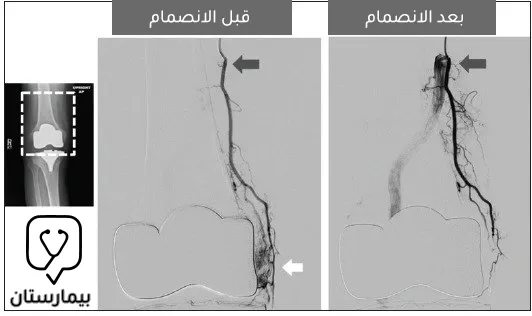يُعتبر انصمام شريان الركبة تقنيةً تداخليةً تم استخدامها حديثاً في علاج آلام الركبة الناتجة عن التهاب المفاصل التنكسي مع القليل من الآثار الجانبية ونسب نجاح جيدة.
مشكلة آلام الركبة التالية لالتهاب المفاصل التنكسي
يعد ألم الركبة المزمن التالي للإصابة بالتهاب المفاصل التنكسي (الفصال العظمي) سبباً رئيسياً لإعاقة الحركة لدى المرضى الذين تزيد أعمارهم عن 50 عاماً وبنسبة انتشار حوالي 25-30%، ويتطلب هذا الألم علاجات طبية مختلفة بدءاً من التدبير غير الدوائي للأعراض إلى تقويم مفصل الركبة بالكامل كما يؤدي إلى انخفاض في جودة الحياة بشكل عام. (1)
يشمل العلاج الأولي لألم الركبة التالي للإصابة بالتهاب المفاصل التنكسي تدابير محافظة مثل العلاج الفيزيائي واستخدام دعامات الركبة والأدوية المسكنة/المضادة للالتهابات، وعندما يصبح الألم أكثر حدة يتم تطبيق الحقن داخل المفصل بالكورتيكوستيروئيدات ومركبات حمض الهيالورونيك، وإذا كان الألم لا يزال محدداً للحركة لدى المرضى على الرغم من هذه التدابير فيمكن استخدام العلاجات الجراحية بما في ذلك استبدال المفصل الجزئي والكلي. (2)
إن حدوث الألم في التهاب مفصل الركبة التنكسي ينتج عن تآكل الغضروف المفصلي مما يؤدي إلى احتكاك عظم الفخذ والساق والرضفة ببعضها البعض، ومع جهة أخرى هناك مقترحات حديثة تشير إلى أن الألم أقل ميكانيكية وغالباً ما يكون نتيجة لالتهاب مزمن. ويؤدي تنكس الغضروف المفصلي إلى حدوث سلسلة تفاعلات التهابية في النسيج الزليلي داخل المفصل، وتسبب هذه العوامل الالتهابية نمو أوعية دموية وأعصاب جديدة داخل الغشاء الزليلي يكون تهيجها في نهاية المطاف المنبه الذي يسبب آلام مفصلية عميقة في الركبة المصابة بالالتهاب المفاصل التنكسي. (2)

ما هو انصمام شريان الركبة؟
تم اقتراح انصمام شريان الركبة مؤخراً كطريقة إضافية -وغالباً ما تكون تكميلية- لتدبير التهاب مفصل الركبة التنكسي الخفيف إلى المتوسط، وقد كشفت الدراسات المبكرة عن نتائج واعدة مع مضاعفات طفيفة عابرة فقط بعد العملية. (1)
إن انصمام الشرايين داخل مفصل الركبة ليس مفهوماً مستحدثاً فهناك تقارير متعددة عن الانصمام لعلاج انصباب المفصل الدموي الذي يحدث بشكل شائع بعد استبدال مفصل الركبة الكامل، وقد أوضحت أن انسداد الشرايين الركبية بجزيئات أو لفائف معدنية آمن ولا يحمل خطر حدوث انصمام غير مستهدف يقود إلى اضطراب في الأوعية الدموية في الأطراف السفلية البعيدة أو احتشاء العظام. (2)
لقد أثبت الجراح أوكونو (Okuno) وزملاؤه في اليابان فكرة أن إنصمام النسيج الزليلي داخل المفصل مفرط التروية الدموية يمكن أن يقلل الألم الثانوي للركبة لأول مرة في عام 2014، ففي تجربة شملت 14 مريضاً أدى إنصمام شريان الركبة إلى انخفاض الألم والعجز لمدة تصل إلى 19 شهراً بعد العلاج. وفي تجربة أخرى أجراها على مجموعة من 72 مريضاً (95 ركبة) تم علاجهم بانصمام شريان الركبة عام 2017 أفاد 86% من المرضى أن آلامهم قد انخفضت بنسبة 50% على الأقل بعد أشهر من العملية، كما تبين أن تأثير انصمام شريان الركبة يمكن أن يستمر لمدة تصل إلى عامين في بعض المرضى. (2)
كان الاكتشاف الواعد الآخر هو أن غالبية المرضى الذين كانوا يتناولون بشكل روتيني الأدوية المسكنة القوية (الأفيونية) ومضادة الالتهابات غير الستيرويدئية قبل إجراء انصمام شريان الركبة لم يعودوا يتناولونها بعد 6 أشهر من الإجراء. (2)
طريقة إجراء إنصمام شريان الركبة
معايير اختيار المرضى
- عمر المريض ≥ 18 سنة
- آلام الركبة مستمرة لمدة 6 أشهر
- حدوث ألم الركبة (مقياس الألم ≥ 4-8) على الأقل خلال نصف أيام الشهر السابق
- استجابة غير كافية للعلاج المحافظ لمدة 6 أشهر على الأقل
- وجود علامات التهاب المفاصل التنكسي في الركبة بالتصوير الشعاعي (3)
تشريح الأوعية الدموية للركبة
يعد الفهم الأساسي لتشريح الركبة أمراً بالغ الأهمية لتحديد الأوعية الدموية المستهدفة ومواد الانصمام بطريقة آمنة وفعالة، ففي التهاب المفاصل التنكسي في الركبة يكون تأثير المرض على جزء المفصل الانسي أكبر 5-10 مرات من الجزء الوحشي، لذلك غالباً ما تكون فروع الشرايين الركبية الانسيّة والنازلة هي الأوعية الدموية المستهدفة بالانصمام، وعادةً ما يستهدف الانصمام اثنين إلى ثلاثة من الأوعية الدموية مفرطة التفرعات لكل ركبة بسبب الحاجة إلى الحفاظ على بعض إمدادات التروية الدموية إلى المحفظة المفصلية. (4)
إن شريان الركبة الأوسط أو الناصف هو المغذي الرئيسي للرباط الصليبي الأمامي والخلفي، بينما توفر الشرايين الركبية الإنسية والوحشية السفلية الأوعية التغذية الدموية للرضفة والوتر الرضفي المرتبط بها، إضافة إلى أن الفروع الجلدية الناشئة من الجانب القريب من الشرايين الركبية تقوم بتوفير التغذية الدموية لمكونات الركبة الأساسية. (4)
خطوات العملية
تُجرى عملية انصمام شريان الركبة للمريض تحت التسكين المعتدل في جناح الأشعة التداخلية في المستشفى، ويتم تمييز المناطق البؤرية للألم التي حددها المريض بمادة ظليلة للأشعة مباشرة قبل العملية، ثم يتم إعطاء مخدر موضعي (ليدوكائين 1%) من أجل الدخول عبر الفخذ. (5)
يتم الوصول إلى الشريان الفخذي المشترك المماثل بإبرة قياس 21 ثم يستبدل بقثطرة وعائية قياس 3F (في المرضى ذوي مؤشر كتلة الجسم المرتفع يتم الوصول إلى شريان الفخذ المقابل ومن ثم يتم التقدم بقثطرة وعائية قياس 6F فوق تشعب الشريان الحرقفي إلى الشريان الفخذي المشترك للطرف المستهدف(. (5)
يُجرى تصوير الأوعية الدموية الظليل للشرايين الفخذية السطحية والشرايين المأبضية من خلال القثطرة الوريدية، ويتبع ذلك التصوير الطبقي المحوري للركبة من أجل الحصول على تقييم ثلاثي الأبعاد للتروية الدموية في شرايين الركبة. (5)
يتم قثطرة الشرايين الركبية المستهدفة التي تغذي مناطق الألم باستخدام قثطرة وعائية دقيقة قياس (F 1.7-2.4). (5)
يتم إجراء الانصمام (إغلاق الشريان) بجزيئات إمبوزين 100 مم حتى يحدث انسداد في التشعبات الوعائية البعيدة المستهدفة، ومن ثم يتم الحفاظ على جريان الدم الطبيعي داخل الشريان المختار. (5)
بعد الانتهاء من إجراء الانصمام يتم إزالة القثطرة الوعائية والضغط مكان ثقب القثطرة يدوياً لمدة 10 دقائق على الأقل ويمنع المريض من الحركة لمدة 3 ساعات على الأقل. (3)
تستغرق هذه العملية عادة 1-2 ساعة ويتم تخريج المريض من المستشفى بعد 4 ساعات من انتهاء العملية. (5)
المواد المستخدمة في إجراء الانصمام
يعد الفهم الشامل لخصائص لكل مادة مستخدم لانسداد ضرورياً لتحسين تطبيقه، ويمكن إعطاء مادة الانصمام العلاجي المثالي عبر أي قسطرة من طرفها دون الخوف من حدوث انصمام بعيد غير مستهدف. (1)
يوجد تصنيفين عامين مستخدمين في علاج التهاب مفصل الركبة التنكسي بانصمام شريان الركبة هما الانصمام المؤقت والانصمام الدائم، وعادة ما تستخدم فقط مواد جزيئية لإحدان الانسداد في الأوعية الدموية ومنطقة احتقان الدم المرضي المستهدفة مع الحفاظ على سلامة التروية الدمية الجانبية من الشرايين الركبية إلى المكونات العظمية والرباطية للركبة، ويعتبر هذا الانصمام الانتقائي للشرايين المرضية والحفاظ على تدفق الدم ضروري أيضاً للتدخلات المستقبلية مثل استبدال مفصل الركبة الكامل. (4)

أحرز الجراح Okuno وزملاؤه في عامي 2013 و2014 نجاحاً باستخدام الايمينينيم وسيلاستاتين الصوديوم كمواد للانصمام (IPM-CS) لعلاج الأوعية الجديدة غير الطبيعية في الحالات العضلية الهيكلية المرضية (اعتلال الأوتار، اعتلال العصب، والتهاب المحفظة اللاصق) التي كانت مقاومة للعلاج المحافظ. (4)
وبناء على ذلك النجاح في تخفيف الألم أجرى Okuno لأول مرة عملية انصمام شريان الركبة لعلاج التهاب مفصل الركبة التنكسي باستخدام IPM-CS (0.5 غ من IPM-CS في 5-10 مل من مادة ظليلة موسومة باليود)، كما استخدم الجزئيات المجهرية الصمغية الدائمة للمرضى الذين يعانون من الحساسية تجاه IPM-CS. (4)
إن مادة الانصمام IPM-CS هي عبارة عن خليط بلوري مضاد حيوي يملك تأثيرات انسداد عابرة عند تخفيفه بالمادة الظليلة، وهو الاختيار الأكثر شيوعاً لإجراء عملية انصمام شريان الركبة لعلاج التهاب مفصل الركبة التنكسي خارج الولايات المتحدة مع حجم جزيئي (10-70 ميكرون تقريباً). إضافة إلى هذا الخليط استخدمت دراسات أخرى جزيئات دائمة في علمية الانصمام بما في ذلك جزيئات Embozene المجهرية (بحجم 75-100 ميكرون) وجزيئات Embospheres (بحجم 100-300 ميكرون) وكحول عديد الفينيل (بحجم 10-70 ميكرون). (4)
الآثار الجانبية لعملية انصمام شريان الركبة
تعتبر الآثار الجانبية والمضاعفات بعد عملية انصمام شريان الركبة في التهاب مفصل الركبة التنكسي طفيفة وعابرة وترتبط غالباً بمادة الانصمام المستخدمة، وأكثر هذه المضاعفات شيوعاً حمامى جلدية عابرة في 12% من المرضى، إذ كانت نسبة الحدوث وطول المدة في الانسداد الدائم (63% لمدة 1-3 أشهر) مقارنةً بالانسداد العابر (2.5% لمدة 3 أسابيع). (4)
وتضمنت المضاعفات الأقل شيوعاً الأورام الدموية في موقع دخول ابرة القثطرة بنسبة 10%، تنمل حسي أخمصي بنسبة 1.1%، حمى خفيفة عابرة بنسبة 0.55%، وتزول جميعها في غضون أسبوعين، وعلى الرغم من أن المضاعفات العامة كانت طفيفة وعابرة إلا أنه يبدو أن هناك زيادة في حدوث مضاعفات مع استخدام مواد الانصمام الدائمة مقارنة بمواد الانصمام المؤقتة. (4)
تقييم الدور العلاجي لانصمام شريان الركبة
نظراً لتقييم عملية انصمام شريان الركبة على أنها علاج للألم سيكون من المهم تحديد ما إذا كان تأثيرها العلاجي أكبر من تأثير العلاج الوهمي، وقد أظهرت النتائج المقدمة في الاجتماع السنوي لجمعية الأشعة التداخلية عام 2020 أن عملية انصمام شريان الركبة أكثر فاعلية بشكل ملحوظ من تصوير الأوعية الوهمية في تقليل الألم وتحسين الوظيفة بعد شهر واحد من العملية. (2)
إن عملية انصمام شريان الركبة هي تقنية مبتكرة يتم تقييمها كطريقة إضافية -غالباً ما تكون تكميلية- لتخفيف الآلام المزمنة التالية لالتهاب مفصل الركبة التنكسي. في الوقت الحالي، يبدو أن البيانات المتاحة تشير إلى أن عملية انصمام شريان الركبة هو خيار إضافي معقول وآمن لتخفيف الألم وتقليل استخدام الأدوية المسكنة وعلاجات الحقن وتحسين الحالة الوظيفية، ويمكن من الناحية النظرية للمرضى الذين خضعوا لهذه العملية القيام باستبدال مفصل الركبة في سن أكبر مقارنة بالمرضى الآخرين، وهي فائدة كبيرة محتملة تتطلب متابعة طويلة الأجل لفهم أفضل. (1)
المراجع:
- Torkian et al. Osteoarthritis-Related Knee Pain Treated With Genicular Artery Embolization. The Orthopaedic Journal of Sports Medicine 2021;9:6.
- Ari J. Isaacson. Genicular Artery Embolization to Treat Osteoarthritic Knee Pain. ENDOVASCULAR TODAY 2021;20,4.
- van Zadelhoff et al. Genicular artery embolization as a novel treatment for mild to moderate knee osteoarthritis: protocol design of a randomized sham-controlled clinical trial. Trials 2022.
- Heller et al. Geniculate Artery Embolization: Role in Knee Hemarthrosis and Osteoarthritis. RSNA, 2021;42,1.
- Padia A. S, et al. Genicular Artery Embolization for the Treatment of Symptomatic Knee Osteoarthritis. JBJS Open Access 2021: e21.00085.

